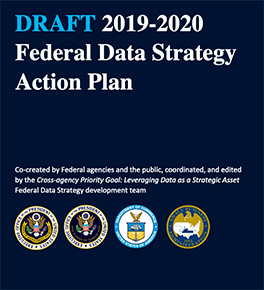
Collaboration Across Government and Enabling Strategies: Effective Implementation of the Federal Data Strategy Action Plan

The Data Coalition and the Office of Management and Budget (OMB) recently co-sponsored a public forum on the Federal Data Strategy’s draft 2019-2020 Action Plan. The event provided an opportunity for industry, academic, and non-profit speakers to provide comments on 16 draft action items in the Federal Data Strategy.
As one of the commenters at the forum, my last post offered written remarks about the strategy. These remarks focused on opportunities to drive effective implementation across the strategy and for a number of the individual action plans, were based largely on lessons from our research and engagement with government leaders. These opportunities focused on three areas:
1) Operationalizing the strategy and actions
2) Collaborating across governments and sectors to amplify the impact of the strategy
3) Enabling the strategy to ensure that data use evolves with the pace of technological change
Today’s post will discuss “collaborating across governments and sectors to amplify the impact of the strategy” and “enabling the strategy to ensure that data use evolves with the pace of technological change” – building on the last post that discussed “operationalizing the strategy and actions.”
Collaborating
Regarding collaboration, most of the strategy focuses on governmentwide capacity building, like the data.gov tools in Action 7 (“Pilot an automated inventory tool for data.gov”) and Action 8 (“Pilot standard data catalogs for data.gov”). Other cross-agency “community actions” are around AI, financial, and geospatial data, and still others address agency-specific steps. Since the use of data by companies, researchers, and citizens often crosses boundaries, developing additional pathways for collaboration can help leverage user-centric data actions. For example, agencies could be asked to form mission-based coalitions around health data across HHS, VA, and DOD; public safety data across DHS and DOJ; or environmental data across EPA, DOI, and USDA.
Similarly, the impact of Federal data would be enhanced through joint efforts that cross levels of government and even sectors, in two ways.
- First, agencies deliver vast amounts of benefits through grants to state and local governments.Beneficiaries, delivery partners, and case workers would be able to leverage common data structures to improve service quality through incentives for intergovernmental data strategies and actions.Some models for this impact exist in the Center’s report, Collaboration Across Boundaries.
- Second, various elements of the strategy note the economic benefits of open data that enable commercialization of new applications to benefit consumers; weather data from NOAA serves as a classic example.The converse is also true, in that data from the private and non-profit sectors – if properly obtained, consistent with the Paperwork Reduction Act with safeguards for confidentiality and propriety information – can provide great benefit to agencies.Increasing cross-sector collaboration could have a significant multiplier effect for agencies in accessing a range of data that can drive better decisions without large expenditures or burdens around new data collection. The Commerce Department’s Opportunity project, subject of the recent Center report Agile Problem Solving in Government, demonstrates how open data can drive public-private collaboration around new solutions that address agency mission challenges.
Enabling
This area concerns integrating data and technology strategies to ensure that the government remains agile in keeping up with the pace of change. In addition to the AI research agenda in Action 9, “Improve data resources for AI research and development,” technology is addressed in Action 4, “Develop a data protection toolkit” and Action 13, “Assess data and related infrastructure maturity.”
AI is one of multiple emerging technologies that enable private and public sector organizations to use analytics in new ways. Other technologies include robotic process automation, blockchain, and even next-generation paradigms around 5G and quantum computing. All of these advances have importance for how they can help organizations become more of a “cognitive enterprise,” which can access and respond to data in real time to improve decisions, processes, and services. Our Center has written multiple reports on how government can best implement this emerging suite of technologies, referenced below:
More Than Meets AI, with the Partnership for Public Service (2019)
A Roadmap for IT Modernization in Government, by Greg Dawson, Arizona State University (2018)
Accordingly, a specific focus of the action plan could call for a secure technology enablement strategy that brings together these various elements. Two specific steps might include:
- Expanding data protection actions in Action 4 with the primary focus on confidentiality of statistical data to ensure appropriate protection for all data -- data security is a critical element to effective use and confidence around Federal data.
- Adding to Action 13 on infrastructure maturity a criterion for agencies to consider assessing their maturity in developing a secure, hybrid cloud strategy, one that provides a foundation for effective and efficient data access, sharing, and analysis across multiple platforms.
Conclusion: A Look Ahead
The Center’s 2018 book, Government For The Future, includes a 20-year review of the evolution of the use of federal data, addressing developments around transparency and openness, as well as opportunities to make data actionable.
The concluding chapter in Government For The Future, on Data and Analytics, highlights the importance of new communication tools that can leverage data to address challenges, make progress, and point to potential paths forward for improved mission performance. Such tools can help drive steps in the Action Plan through emphasis on creating data standards, inventories, and skills to increase the “supply” of data. As noted above, equally important will be the need to develop a strategy around creating “demand” for data to maintain sustainability over the long term – the lack of a strategy to build demand has limited implementation of key management initiatives in the past. The IBM Center looks forward to collaborating with government leaders and academic experts on effective implementation for the future.



